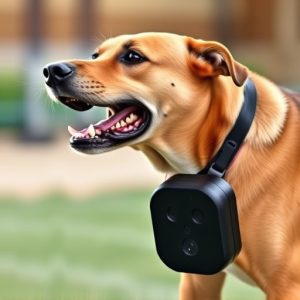Mastering Dog Repellents: Best Vibration Settings for Effective Deterrence
Modern dog repellent devices use advanced sound, scent, and vibration technologies, with adjustable…….
Modern dog repellent devices use advanced sound, scent, and vibration technologies, with adjustable best vibration settings (50-200 Hz) that mimic natural disturbances. These humane, environmentally friendly tools allow homeowners to deter dogs from large yards or open spaces without causing harm. To be effective, start at lower settings, gradually increase, and consistently use repellents alongside training and fencing for best results in modifying canine behavior.
Introducing our comprehensive guide on dog repellent devices with distance control – a revolutionary tool for managing canine interactions. These innovative gadgets offer a humane and effective solution for keeping dogs at bay, ideal for outdoor spaces. In this article, we’ll explore how these devices work, uncover essential features to consider, and provide expert tips on the best vibration settings for optimal dog deterrence. Learn how to use them safely and responsibly while ensuring your space remains dog-free when needed. Discover the top choices and settings for the best vibration settings dog repellent device.
- Understanding Dog Repellent Devices: How They Work
- Key Features to Consider When Choosing a Dog Repellent with Distance Control
- Best Vibration Settings for Effective Dog Deterrence
- Safety and Training Tips for Using Dog Repellents with Distance Control
Understanding Dog Repellent Devices: How They Work
Dog repellent devices have evolved from traditional spray and electric shock methods to more sophisticated tools that utilize sound, scent, and vibration to deter canine intruders. These modern repellents often incorporate adjustable settings, allowing users to customize the intensity of their response based on the perceived threat. The best vibration settings for a dog repellent device are those that create a low, consistent hum, mimicking natural environmental noises but at an uncomfortable frequency range for dogs.
When activated, these devices emit a series of ultrasonic or subsonic vibrations designed to be inaudible to humans but irritating to dogs’ sensitive hearing. By setting the vibration level appropriately, users can ensure the device is effective without causing any harm or distress to nearby people or pets. This technology offers a humane and environmentally friendly alternative to traditional repellents, providing a gentle nudge for dogs to stay away while maintaining peace of mind for homeowners.
Key Features to Consider When Choosing a Dog Repellent with Distance Control
When choosing a dog repellent with distance control, several key features should guide your decision to ensure effectiveness and user-friendliness. One of the most important considerations is the vibration settings. The best device will offer adjustable vibrations that can be tailored to different situations, environments, and even individual dogs’ sensitivities. This flexibility ensures you can find the optimal level to deter canine intruders without causing discomfort or stress.
Additionally, look for products with a long-range control feature, allowing you to activate the repellent from a distance. This is crucial for managing pets in large yards or open spaces. A reliable range means you can effectively protect your territory and reduce unwanted dog visits from a safe distance, enhancing your control over the situation.
Best Vibration Settings for Effective Dog Deterrence
When it comes to dog repellents with distance control, understanding the best vibration settings is key to effective deterrence. The ideal frequency and intensity should aim to mimic natural disturbances that dogs typically avoid, such as the sounds of potential predators or territorial intruders. Most devices offer adjustable vibration levels, allowing users to customize the sensitivity according to their needs. Starting with a lower setting and gradually increasing it can help train pets to recognize and respond to the repellent without causing unnecessary stress or discomfort.
The best vibration settings for dog repellents are often those that fall within the range of 50-200 Hz, as these frequencies have been shown to be particularly effective in deterring canine behavior. Experimenting with different intensities during training sessions can help identify the optimal level for your pet. Remember, consistency is crucial; using the repellent regularly at the chosen setting will reinforce the message to your dog, teaching them to avoid certain areas without resorting to harsher methods.
Safety and Training Tips for Using Dog Repellents with Distance Control
When using dog repellents with distance control, safety should always be your top priority. These devices emit vibrations or sounds to deter dogs from approaching, but it’s crucial to select the best vibration settings for optimal effectiveness while minimizing potential harm to nearby humans and pets. Always follow the manufacturer’s instructions and consider testing the device in a controlled environment before full deployment. Additionally, keep in mind that these repellents are not a substitute for proper training or fencing; they serve as a supplementary tool to reinforce positive behavior.
Training is another key aspect to ensure successful use of dog repellents with distance control. Teach your pet basic commands like “stay” and “back away” before introducing the device. Positive reinforcement techniques, such as rewarding good behavior, can help your pet associate the repellent’s activation with a desired response. Regular practice sessions in various environments will make your pet more responsive to the repellent’s signal, enhancing its overall effectiveness. Remember, consistency is key; maintain regular training sessions and be patient, as it may take time for your pet to fully understand and comply with the repellent’s cues.
When it comes to choosing a dog repellent with distance control, understanding its mechanics, key features, and safety tips is paramount. By selecting the right vibration settings and properly training your pet, you can achieve effective deterrence without causing harm. Remember, the best vibration settings will vary based on your dog’s behavior and sensitivity, so experimentation and adjustment are key. With the right approach, these devices offer a humane and efficient solution to manage canine interactions in various environments.


